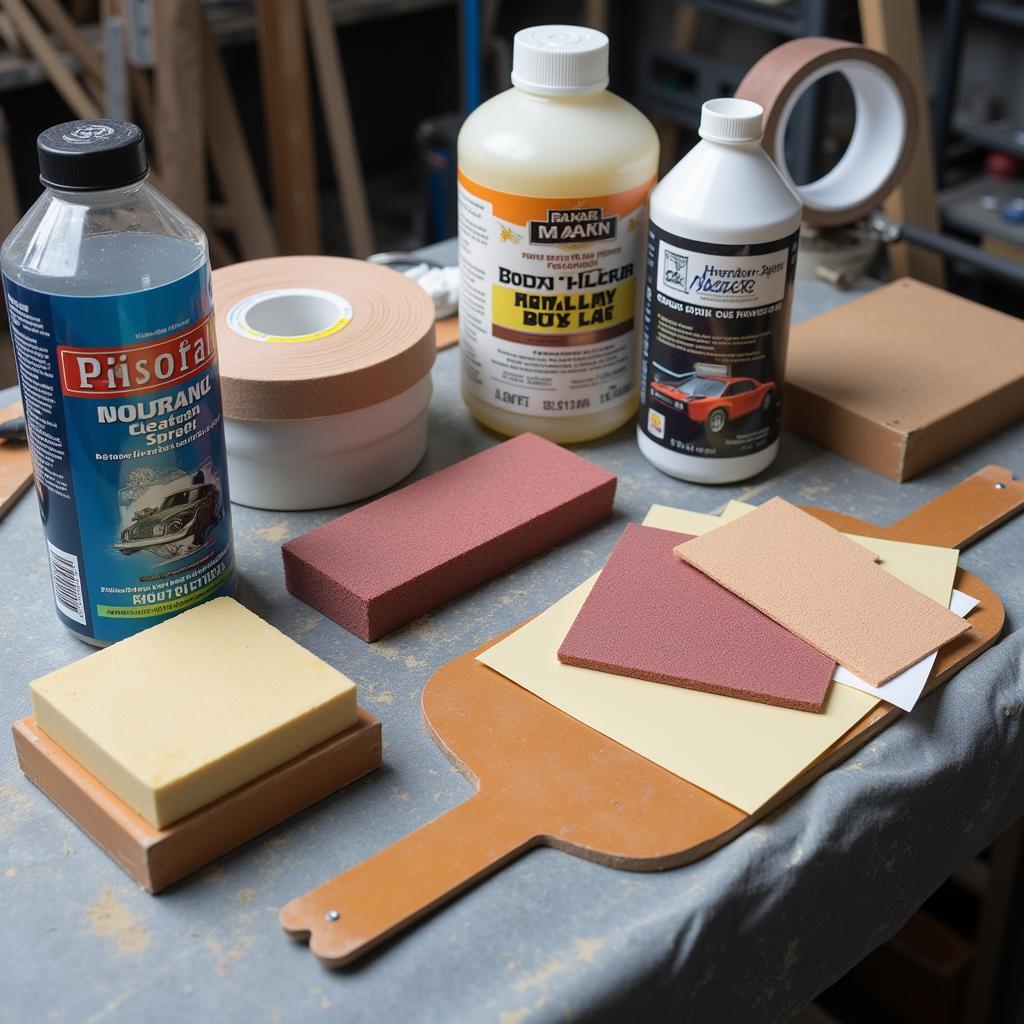Getting a professional-looking paint job on your car doesn’t have to mean breaking the bank. With the right tools and a bit of patience, you can achieve impressive results yourself. This guide will cover all the Tools Needed To Paint A Car, from prepping the surface to laying down the final clear coat.
Whether you’re a seasoned DIYer or a complete beginner, understanding the tools needed to paint a car is crucial for a successful outcome. A proper paint job not only enhances your vehicle’s aesthetic appeal but also protects it from the elements. Choosing the right tools can significantly impact the final result. For example, using a high-quality spray gun will result in a smoother, more even finish compared to a cheaper model. Similarly, proper sanding tools are essential for creating a smooth surface for the paint to adhere to. You can find a variety of car door tools that can assist in the preparation process.
Essential Tools for Car Painting Preparation
Before you even think about applying paint, proper preparation is key. This stage involves cleaning, sanding, and priming the car’s surface. Here are the essential tools you’ll need:
- Cleaning Supplies: A good car wash soap, degreaser, wax and grease remover, and microfiber towels are essential for removing dirt, grime, and any existing wax.
- Sandpaper: A variety of grits, from coarse to fine, will be necessary for smoothing imperfections and creating a good surface for the primer and paint to adhere to. Start with a coarser grit (e.g., 400) for initial sanding and progressively move to finer grits (e.g., 2000) for a smooth finish.
- Sanding Blocks: These provide an even surface for sanding, preventing uneven pressure and swirl marks.
- Masking Tape and Paper: Protect areas you don’t want to be painted, such as windows, trim, and lights.
- Body Filler and Spreader: For filling dents and scratches, you’ll need body filler and a spreader to apply it smoothly.
- Primer and Applicator: Primer provides a uniform base for the paint and helps it adhere better. You can use a spray gun, aerosol can, or even a brush/roller depending on your preference and the size of the area.
Need to remove your car seat before painting? Check out our guide on what tools do i need to remove a car seat.
 Car Painting Preparation Tools
Car Painting Preparation Tools
Tools for Applying the Paint
Once the preparation is complete, it’s time to apply the paint. Here are the essential tools for this stage:
- Paint Spray Gun: A high-quality spray gun is crucial for achieving a smooth, even coat of paint. Different types of spray guns are available, including HVLP (High Volume, Low Pressure) and LVLP (Low Volume, Low Pressure) guns.
- Air Compressor: If you’re using a spray gun, you’ll need an air compressor to provide the necessary air pressure.
- Paint Thinner/Reducer: This is used to thin the paint to the correct viscosity for spraying.
- Mixing Cups and Sticks: Accurate mixing of the paint and thinner is crucial for consistent results.
- Strainers: These remove any debris or contaminants from the paint before it goes into the spray gun.
If you’re looking to upgrade your car toolkit, take a look at our recommendations for the best basic car tool kit.
Finishing Touches and Safety Gear
After the paint has dried, you might want to apply a clear coat for added protection and shine. Here are some additional tools and safety gear you’ll need throughout the process:
- Clear Coat and Applicator: Apply the clear coat using the same method as the paint.
- Polishing Compounds and Pads: These are used to remove any imperfections and achieve a high-gloss finish after the clear coat has cured.
- Safety Glasses and Respirator: Protect your eyes and lungs from paint fumes and dust.
- Gloves: Protect your hands from chemicals and paint.
Having the right tweezerman no-slip skin care tool how to use can also be helpful for minor detailing work during the painting process.
Conclusion
Painting a car yourself can be a rewarding experience, saving you money and giving you a sense of accomplishment. By understanding the tools needed to paint a car and following the proper procedures, you can achieve professional-looking results. Remember to prioritize safety and invest in quality tools for the best possible outcome. With the right preparation and the correct tools, you can transform your car’s appearance and protect it for years to come.
FAQ
- What type of paint should I use for my car? Acrylic lacquer and acrylic enamel are popular choices for DIY car painting.
- Do I need a primer? Yes, primer is essential for proper paint adhesion and a uniform finish.
- How long does it take for car paint to dry? Drying times vary depending on the type of paint and environmental conditions, but generally, it takes several hours to a few days.
- Can I paint my car outdoors? It’s best to paint in a well-ventilated, dust-free environment, preferably indoors.
- How do I clean my spray gun after use? Follow the manufacturer’s instructions for cleaning your specific spray gun model. Thorough cleaning is essential for maintaining the gun’s performance.
- What is the best way to remove old paint from a car? Sanding and chemical strippers are common methods for removing old paint.
- How many coats of paint do I need to apply? Typically, 2-3 coats of paint are recommended, allowing sufficient drying time between each coat.
For information on tools for specific car repairs, check out our article on car door tools.
If you need professional nail care tools for ingrown toe, you can find some valuable information on our website.
Need assistance with your car diagnostics? Contact us via WhatsApp: +1(641)206-8880, Email: [email protected] or visit us at 910 Cedar Lane, Chicago, IL 60605, USA. We have a 24/7 customer support team.

Leave a Reply